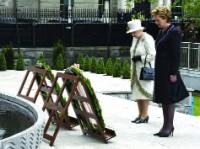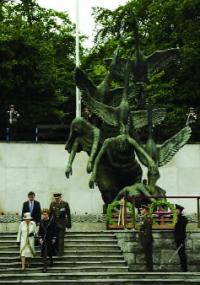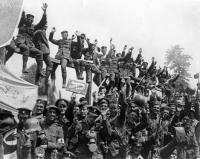Commemoration and conciliation during the royal visit
Published in 20th-century / Contemporary History, Issue 4 (July/August 2011), Platform, Volume 19 ‘The people are not only enchanted with the queen and the gracious kindness of her manner, and the confidence she has shown in them, but they are pleased with themselves for their own good feelings and behaviour, which they consider have removed the barriers that hitherto existed between the sovereign and themselves, and they now occupy a higher position in the eyes of the world.’
‘The people are not only enchanted with the queen and the gracious kindness of her manner, and the confidence she has shown in them, but they are pleased with themselves for their own good feelings and behaviour, which they consider have removed the barriers that hitherto existed between the sovereign and themselves, and they now occupy a higher position in the eyes of the world.’
So wrote the Irish viceroy, Lord Clarendon, to the British home secretary, Sir George Grey, in the wake of Queen Victoria’s first visit to Ireland in 1849. Yet for all the talk of our ‘maturity’ during the state visit in May, the above could just as easily describe the Irish response to Queen Elizabeth II. Many Irish people were genuinely impressed with the apparently gracious bearing of the queen and theduke of Edinburgh, but we were perhaps even more impressed with our own generosity of spirit and dignified hospitality, as embodied by President McAleese and her husband Martin. At a time of unprecedented uncertainty, anxiety and humiliation in Irish life,we, and the rest of the world, were shown a picture of ourselves at our most magnanimous and we very much liked what we saw. Given our avid consumption of Britishtelevision, literature and music, and, not least,our passion for premiership football, one would arguably be hard pushed to find a more Anglophile nation than Ireland. And yet the delirious pleasure we experience when we beat England in rugby or cricket, or when someone else beats them in soccer, reflectsthe degree of popular Anglophobia that still pervades Irish society. This contrary ambivalence towards our neighbours is of course impossible to understand without reference to the past, and the queen’s visit was such a resounding diplomatic success partly because so many of her official engagements involved a sensitive but direct and unflinching acknowledgement of the very mixed history of Anglo-Irish relations.

The reverential demeanour of the queen at the Garden of Remembrance was particularly unexpected and moving. Oisín Kelly’s enormous sculpture of the Children of Lir commemorates generations of Irish men and women who fought and died to end British rule in Ireland. That the British monarch was prepared to bow her head in recognition of their sacrifice is truly historic. (International Business Times)
The willingness of both sides to approach the past in a spirit of mutual respect and understanding was particularly evident during her tour of Croke Park and at the wreath-laying ceremonies at the Garden of Remembrance in Parnell Square and the National War Memorial at Islandbridge. The reverential demeanour of the queen at the Garden of Remembrance was particularly unexpected and moving and seems to have won over many of us who were formerly cynical or simply indifferent to the whole notion of a royal visit. There’s no getting around the fact that Oisín Kelly’s enormous sculpture of the Children of Lir commemorates generations of staunchly republican Irish men and women who fought and died to end British rule in Ireland. That the British monarch was prepared to bow her head in recognition of their sacrifice, in much the same way that she bows her head at the Cenotaph in London, is truly historic. Such a momentous gesture could not have been made without years of behind-the-scenes diplomacy and conciliation, and, importantly, without some level of mutual regard and trust between the two heads of state.
The ceremony at Islandbridge the following afternoon, at which President McAleese and Queen Elizabeth performed an almost identical act of homage to the Irish dead of the First World War, was less unexpected but no less moving. The president’s interest in the Irish experience of the ‘war to end all wars’ is well known. Her inauguration, which took place on 11 November 1997, was somewhat marred by a controversy over her decision not to wear a poppy for the occasion. Ever since then, however, she has been at the forefront of attempts to use the Irish memory of the First World War as a means of finding common ground, and thus common feeling, between nationalists and unionists in the North. Indeed, the first time Mrs McAleese and the queen appeared together in public was at the opening of the very consciously cross-community Island of Ireland Peace Tower at Messines in 1998. The ceremony at Islandbridge therefore marked a fitting culmination of her efforts to make the memory of the war in Ireland less territorial.
A whole range of different factors, not all of them political, motivated the Irishmen who volunteered to serve in the British army between 1914 and 1918. And it should be remembered that those who were politically driven were loyal to diametrically opposed ideologies and had very different plans for Ireland’s future in the post-war world. Nationalist and unionist soldiers nonetheless endured the same deprivation and horror on the Western Front and elsewhere, and in at least one major action, the Battle of Messines in 1917, they fought and died together. The Easter Rising and the subsequent resurgence of militant republicanism would, however, ensure that the country to which Irish veterans of the war returned was quite different from the one they had left. The Anglo-Irish War and partition would in turn mean that for the rest of the twentieth century the Irish memory of the war was highly politicised and divisive.
For unionists, the blood sacrifice of the Ulster Protestants who were killed during the war purchased the right of the six counties to remain within the United Kingdom, and the Battle of the Somme continues to be rivalled only by the Battle of the Boyne in unionist heritage and identity. The men from other parts of the island who had fought in British uniforms were not forgotten in the decades after the Armistice, and some of them were treated quite well by the newly independent state. Yet in terms of commemoration and esteem, there was clearly much greater focus in nationalist Ireland on the men who fought against the forces of the Crown on Easter Week and during the Anglo-Irish War. In the 1980s and more recently, the divided, contested nature of the Irish memory of the war gave rise to a tendency in popular and academic commentary on the period to suggest that one group of Irish combatants acted with honour and patriotism while the other was at best misguided, at worst craven and traitorous. Who was right and who was wrong depended on the political leanings of the journalist or historian in question. Whether the focus was on the rebels of Easter Week, the IRA flying columns or, say, the Royal Dublin Fusiliers, there was also a popular understanding of the Irish Revolution and the First World War as separate, only very tenuously connected events.

Nationalist and unionist soldiers of the Royal Irish Rifles and Royal Inniskilling Fusiliers celebrating their joint victory at Messines in June 1917. But they were loyal to diametrically opposed ideologies and had very different plans for Ireland’s future in the post-war world. (Imperial War Museum)
The wreath-laying ceremonies that took place during the queen’s visit went very much against this territorial view of Irish history. The Irish combatants who fought both for and against the British state during the First World War were honoured with the same solemn reverence. The ceremonies thus represented a very public and official recognition that whether Irishmen served in the British Army or the IRA, or both, many of them quite sincerely believed that they were fighting for Ireland. The implication is that the sacrifices of those who died were equally valid, equally painful for their families, and equally worthy of our respect.
Irish interest in the First World War has never been higher, and while we still have much to learn it can certainly no longer be said that historians or more popular commentators overlook the stories of the Irishmen who fought in the various theatres of war between 1914 and 1918. And yet I suspect that many Dubliners are still unaware of the existence of the memorial park at Islandbridge, and it holds nothing like the place of Glasnevin Cemetery in the consciousness of the city. This is likely to change as we go through the decade of centenaries, which will begin next year with the hundredth anniversary of the signing of the Solemn League and Covenant. Given the intensely ideological and often internecine nature of events in Ireland a hundred years ago, this series of centenary commemorations has the potential to cause no small amount of controversy and ill feeling. Yet the obvious parity of esteem that was shown to the dead of all traditions and communities during the queen’s visit reminds us that one group of Irish combatants does not have to be remembered at the expense of another. HI
Edward Madigan is Princess Grace Fellow at the Centre for War Studies, Trinity College, Dublin.
















